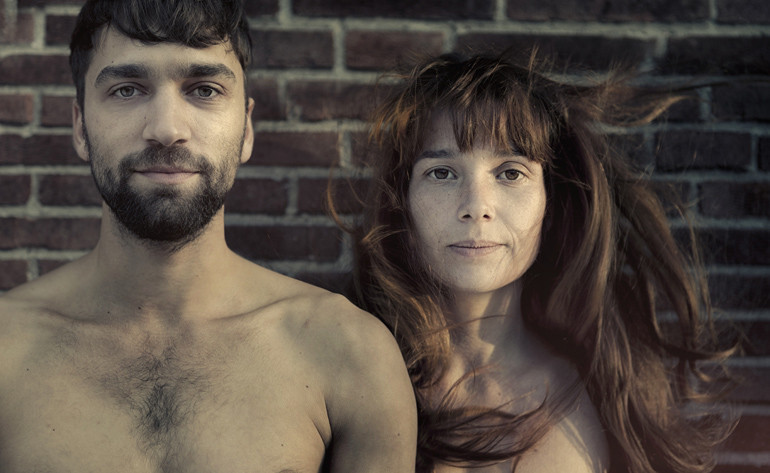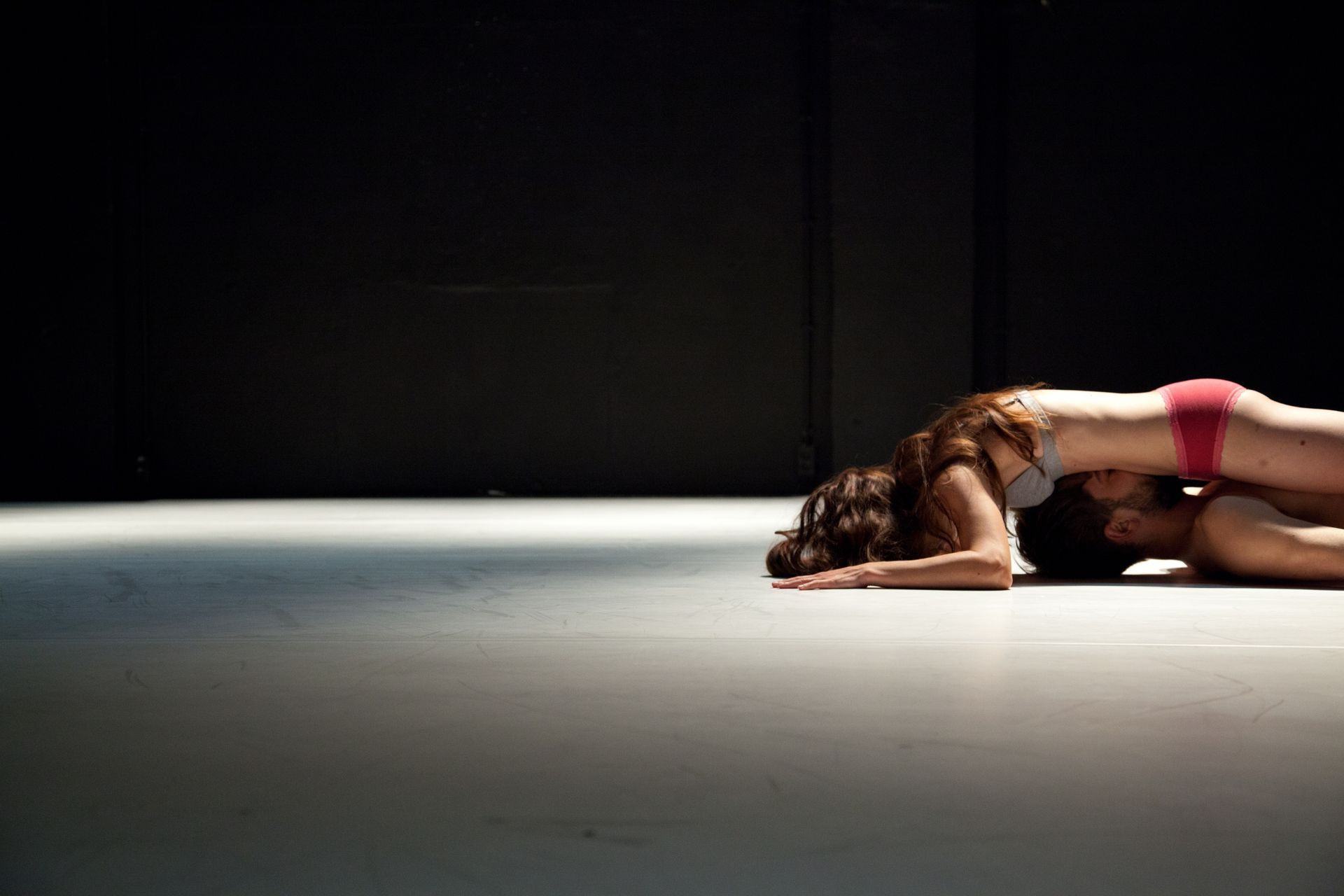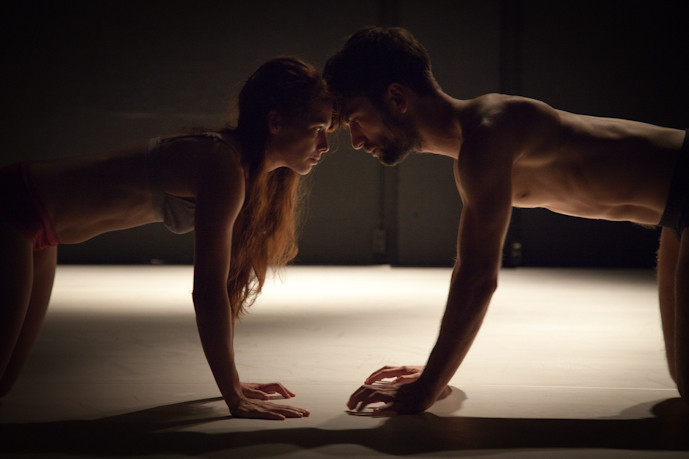
Conversation with Jan Martens
It's an earlier piece and, I wanted to ask you to briefly tell me about it. And maybe you could also tell me how it has changed or how your view on it has changed because it's been more than 10 years now.
It has been more than 10 years yes... We still love the performance very much. It's still the same performers that we premiered it with 11 years ago. It's great for them to revisit the work, to revisit each other also. It's a very intimate piece for them and for me as well. The theme still talks to me, it was very much there during creation, I was just getting out of a very long relationship. So, it was also a way to deal with that for me. I think it's still a very strong piece, I still like it a lot. I think, however, now I would not make it anymore.
The piece is about love. It's a duet. What aspect of love did you want to talk about in this piece? Is it more about sexuality, or intimacy or both?
It was more about the hard work that love can be that if you want a relationship to continue that demands a lot of work. I was looking for a language in which that work would become visible, physically demanding. The solution came with the slowness and with
turning around aspects of contemporary dance. For example, normally if you would lift somebody, the centres would be close to each other, or you would use or speed. While in this piece, we decided to make lifts in which the centres are far apart, and the build-up is very slow.
I think it was only by the premier that we became aware of how the slowness enhanced the sensuality and sexuality of the piece. During creation, we focused on the architecture and only with the light and the costumes did it become kind of sexual.

Why did you do it with a man and a woman?
I think at that time I was not convinced yet that the audience would be able to look through it if it would be two women or two men. I think it would be much harder for an audience to see it as just a relationship. I'm not sure if today that would be easier, but it's a great challenge. Could you make a same sex love duet that is not talking about homosexuality, but just about love between two people?
I really hope that soon enough that won't be considered the challenge, but just something to do. How did you come about to work with Kimmy Ligtvoet and Steven Michel, and what kind of relationship do they have in real life, if any?
They didn't know each other, and I didn't know them. They both auditioned. Though usually after the shows, people ask me if they are a couple. And everybody laughs, because Steven is gay, and Kimmy has 2 kids with her boyfriend. It helps to keep the distance because this work is super intimate. But they nurture a very good relationship, which was not always easy to keep if you have been touring together for 12 years. There's a lot of love for each other. This is for sure.

How did you go on about composing this piece?
The language that we chose became this language because of the two performers. When we started creation, I was not aware that was going to be a slow-motion piece.
It was all about images. It was not about movements. I gave them tasks like I would ask them to make lifts where one person is not touching the floor and their eyes are on the same level, the lifts where the centres are far apart. We then went from one image to the other putting them in the simplest way after each other, and we would go as slow as possible.
Also, I was interested in the idea of the pas de deux as an archetype of dance. Is it still possible to find a new language for it, a different way to talk about these cliché things as attraction and repulsion? Can we still talk about love in new ways?
What about the sweating, is it something necessary or even an expectation we have in relationships?
No, no, I don't think so. I think sometimes it also can just work without any efforts, but maybe that’s naïve. What for me is important is that it the piece becomes real, that it's not only about performing or acting. If the trembling and sweating is real, it becomes a real experience for a spectator, too. So often dances are created to not show the effort, but I think seeing the effort helps us to connect to the performer - we feel that they are human.
The slowness requires incredible control from the performers. What role does control have in this piece and in love, if any?
I think the control talks about the manipulations that can happen in a relationship, as well as of the manipulation of the bodies, the testing of each other's powers. But also, in my work, I love this friction between control and freedom. There is always a very rigid base in the work, the counts, the structure. But I really truly believe that only the structure makes sure that the piece is always there. If it wouldn't have this controlled base, it would not survive on a bad day. Structure gives us the freedom to get to the humanity of the performers.

What is it really that you would like to evoke in an audience? What purpose does the slowness serve for the audience?
I think that the theatre is a place where we can slow down. It's one of the few spaces left in which we can focus for one hour or longer on one moving image. You know, like before we had it in the movies. But now, they also get interrupted. We so easily push pause, we check our Instagram, and then we continue. Theatre is this place where we can train our gaze and train our brain to focus.
Also, I think I'm a choreographer who really works from the perspective of an audience, very simply because I was an audience member for a very long time before I started creating. As an audience member there is this kind of intensity, extremity which is not part of the everyday life, and the theatre is a safe space to experience it. You become part of this intensity which is taking place on stage.
Also, the slowness gives, like a great chance to let yourself be associative. You really have the time to interpret what you see and start thinking about your own life.
Indeed, it's very important, awaking the state of reflection within an audience or giving the time and space to reflect while still connecting to what is happening on stage. That's also why this end of the piece is the way it is: the performers get lost in the dark and there is just this song playing and the lyrics throws you back and makes you ask yourself what music was important for me when I was in love. What was my first dance? I think everybody has connections to music in relation to love, and this ending opens the possibility to be thrown back even more into your own reflection, into your own dealing with relationships of past and present.

Absolutely. It's good you mentioned the music because I wanted to ask in what phase of the process is the music created. Did you work simultaneously with Jaap Van Keulen?
It was kind of simultaneously, there was quickly the idea of love songs, pop songs. When we started working, I asked him to make a soundscape, for example, by making a voice from one pop song meet the beat of another. It became 50-minutes long in which a lot of love pop songs passed by. That was the initial idea. But then I felt it wasn’t working.
The song Willie Deadwilder by Cat Power was already for a long time on my mind, but it's like 18 minutes… What on Earth am I going to do with it? Then I remember we did run-throughs and I decided, let's not put the lyrics into the composition, but let's use them as a projection. I asked Paul Sixta, and we started to work with these projected lyrics, which, at that stage, followed the whole piece through. They would appear and disappear. It also felt like it wasn’t working. Then came with the idea: the first two pieces, the industrial and the less industrial should also be completely made of the Cat Power piece. He slowed it down like eight times or so. All sound we ended up using are manipulations of the amazing Cat Power song. We took that one sentence ‘as long as you're here, I am too’, that is projected very soon in the performance. The rest of the text that is projected at the end is all quotes from other love songs which start with ‘you’. I wanted to find something that talks to the audience
We talked about reflection and how the whole performance gives the audience the time to reflect. I guess for you it must have been a process of a lot of self-work as well. During the artistic process, have you found any new insights about yourself?
It was very turbulent times for me. I think we started creation in July and two days after I broke up with my partner with who I was five years together. I had to move out because we were living together. So, like all this this… The two weeks before the premiere, which was only three months later, I got to know my new boyfriend, who I'm still together with today. We met two weeks before the premiere of Sweat baby sweat, which I think had a very big impact on the piece. During the creation, it became quite cold hearted. The first sequence of the piece used to be the vibe of the whole piece. Then it became much more warm-blooded. With the kiss and the softness coming in, and with the text, and the humour which brings those texts in at the end…. it made it. I also came to realize after those slow-motion parts which last 40 minutes, the audience also needs to relax at a certain point because it is so tense the whole time. I asked myself, how can we make it more warm-blooded? I think that was a consequence of the personal things I was going through at that time.
What I learned was you need to put a lot of work into a relation, but not too much. In my previous relationship, I was working so hard to make it happen, and then I realised, something things should just go fluently. Yes, it's not always easy and you need to work and put the effort in. But this lesson is something which I still carry with me today.
It's interesting, maybe without the artistic process, the break between the two relationships wouldn’t have been this short.
For sure, but I think art should not be too therapeutic. It can be therapeutic. Sweat baby sweat was very therapeutic for me, but I hope that you don't see it just for that. I think that in the in the end, the piece is a work of art. It’s not a diary, it should be a universal work. That's also what I found interesting and still find interesting, how to make it very personal, but on the other hand, not make it too personal, but ubiquitous. It brings interesting work when you find that balance between something that you feel has a core in you and but is not just a diary.
That kind of brings us back to one of the very first things you said, that now 10 years later, you wouldn't want to create this piece. If it's something that you think is not like a diary entry and it's something universal, then why wouldn't you do it again?
Maybe I would do it again, but it would become different, I think. Since Sweat baby sweat, I've invested a lot in different bodies in different ages. We still play Sweat baby sweat and it remains a piece with two very beautiful people. It was very good to do it, also because it was talking about this canon of the pas de deux. But I think my interest lies in different ways now.

















